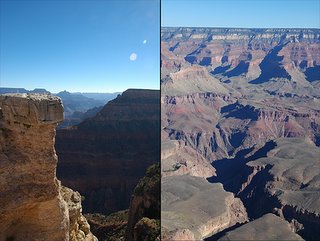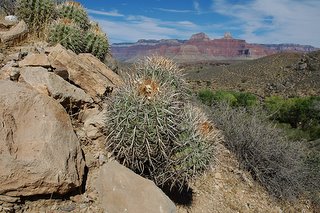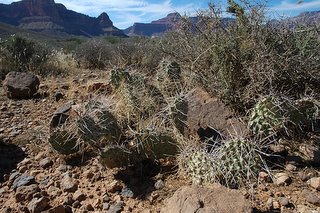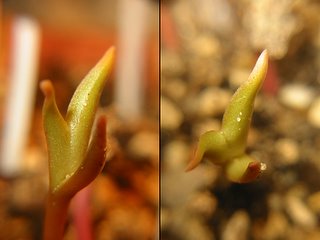
Tricotyledon Echinocactus polycephalus seedling
As mentioned in the previous post I started a handful of Echinocactus polycephalus (SNL 91; Las Vegas, Nevada) from seed a few weeks ago. I didn't achieve impressive germination rates and many of the seedlings were killed off by mold while still enclosed in the humid atmosphere of the germination "tent" - and more have withered after I exposed the seedlings to the harsher environment outside of the plastic bag they germinated in. So for all practical purposes Echinocactus polycephalus (and E. horizonthalonius) live up to their reputation of being extremely difficult to grow from seed.

Echinocactus polycephalus seedling growing its first spines
That being said a few of the seedlings are doing great - exemplified by the Echinocactus polycephalus seedling pictured above, growing its first spines.

Tricotyledon Echinocactus polycephalus seedling - top view
Interestingly one of the Echinocactus polycephalus seedlings turned out to be a tricotyledon. Members of the Cactus family belong to the group of dicotyledons, i.e. their seedlings have two cotyledons or embryonic leaves. So evidently Echinocactus polycephalus is a dicot but for some reason this seedling decided to grow three seed leaves instead of the habitual two.
Polycotyledons could be considered freaks of nature or "mutant" plants but this seedling will probably grow up looking exactly like the other plants from the same batch. The last time I experienced a polycot seedling was some years ago when an Opuntia polyacantha var. hystricina seedling germinated with three seed leaves.

Tricotyledon Opuntia polyacantha var. hystricina seedling
Polycotyledon tomato, chile, aubergine, Cannabis, etc are regularly reported so this is by no means abnormal. It would be interesting to know though if this is affecting the plants in any way (as mentioned, the last time I experienced a tricot seedling the plant grew up to be indistinguishable from the "normal" plants). I'm also curious as to what is causing the extra seed leaves (the Opuntia seedling mentioned above was grown fresh from seed collected in the Grand Canyon; indicating to me that polycots are occurring naturally and are not (only) caused by "mutagens" in the environment).
Tuesday, July 23, 2013
Tricotyledon Echinocactus polycephalus seedling
Wednesday, November 23, 2005
Grand Canyon Cacti
Heading north on Arizona state route 64 from Williams, AZ and driving through Kaibab National Forest, it’s hard to imagine the earth split wide open. When you are standing at the Grand Canyon rim you have to acknowledge that your imagination not always suffices.

View from Mather Point
I went down the canyon, following the Bright Angel Trail to Plateau Point. On the upper part of the trail the cactus vegetation was rather sparse, but after having passed the Indian Gardens and entered the Blackbrush (Coleogyne ramosissima) dominated desertscrub on the Tonto Platform, the cacti became abundant.

Echinocactus polycephalus overlooks the Tonto Platform
Especially Opuntias are massively present, almost covering the ground in some areas. I collected some Opuntia polyacantha var. hystricina seeds (thanks to the friendly people at the cacti_etc mailing list for helping me getting the name correct). The seed donor is depicted below.

Opuntia polyacantha var. hystricina
I’m aware that it’s absolutely stupid to sow cactus seeds at this time of year (in the Northern Hemisphere, that is ;-), but I couldn’t resist the temptation of testing the viability of the seeds. Prior to sowing I soaked the seeds for 14 days and after an additional two weeks in the ground 50% of the seeds have now germinated. I expected the seedlings to be “leggy” but was a bit surprised to see what looks like a tricotyledon?

Tricotyledon Opuntia seedling
The Grand Canyon hike took place September 24, 2005. Additional photos can be found at Grand Canyon Cacti & Succulents.
All Time Most Popular Posts
-
Lophophora williamsii (peyote) populations have diminished in large areas of South Texas where peyoteros harvest the cactus for ceremonial ...
-
On various occasions I've been asked what growing media I'm using for my cactus plants. I don't have a set soil mix recipe as su...
-
Below is a list of retailers/nurseries selling cactus seed and plants. I've only listed vendors I've done business with. If you ar...
-
Most cacti are easily grown from seed - and with a little patience and care they can be grown into beautiful plants. Lophophora williamsi...
-
In last month’s post on the troubled Texan peyoteros I referred to Anderson’s article on the peyote situation in Texas. Given the importanc...
-
Yet another slightly off topic and probably not entirely politically correct post, but I couldn’t help noticing the similarity of my monstr...
-
Flowering stand of San Pedro cacti (Trichocereus pachanoi) To me the main draw of the San Pedro cactus ( Trichocereus pachanoi (syn. Ech...
-
In the June 2008 issue of the Cactus & Co magazine Jaroslav Šnicer, Jaroslav Bohata, and Vojtěch Myšák described a new Lophophora spec...
-
There seems to be an increased focus on the alarming Texas peyote situation. A couple of weeks ago the Houston Press published a mournful, i...
-
I spent two weeks working in Delhi, India during January. I had one weekend off and had planned to spend it in Delhi at my own leisure, but ...


















